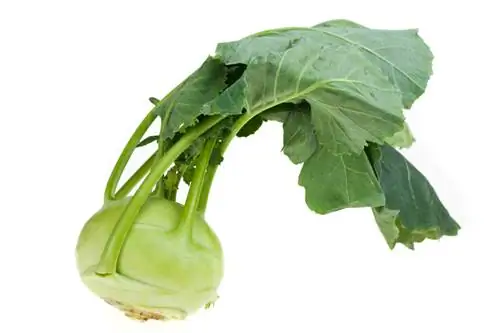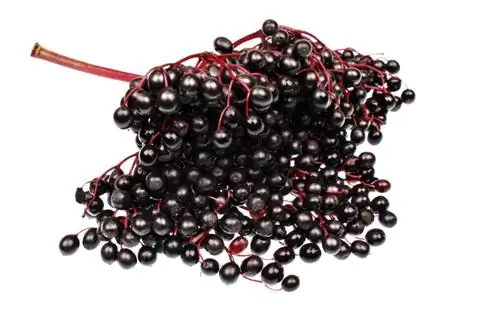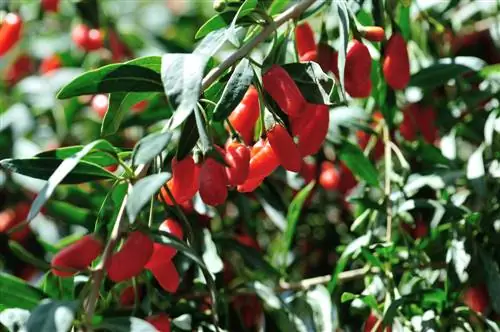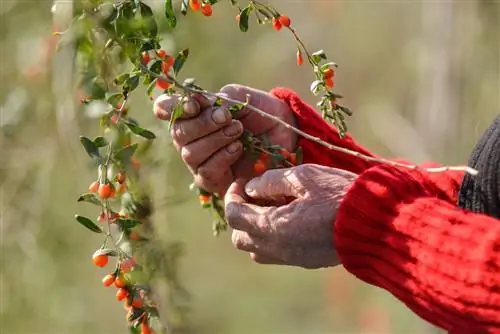- Author admin [email protected].
- Public 2023-12-16 16:46.
- Last modified 2025-01-23 11:21.
Goji berries used to be imported mainly from Asian countries and mostly in dried form. Nowadays, these vitamin-rich berries are increasingly being cultivated on a large scale in Germany and are also planted in many private gardens.

How do you successfully plant goji berries in your own garden?
To plant goji berries in your own garden, choose special yield varieties from specialist retailers, plant them in a sunny location and cut them regularly to create compact bushes with good ventilation. Ideally plant them in spring in well-drained soil.
How to choose suitable plants?
Since the so-called “Common Bocksdorn” or “Devil's Twine” occurs naturally as a plant in some East German regions, hobby gardeners in some places tend to grow cuttings from these mother plants. However, this is usually suboptimal for a high fruit yield, as these plants often bloom little or not at all and therefore of course do not produce any fruit. For cultivation in the garden with the hopeful prospect of a rich harvest, the productive varieties bred for this purpose in Asia should be purchased from specialist retailers.
Which location does the goji berry prefer?
The goji berry is not a very demanding plant and can show acceptable growth even in shady locations. However, stronger growth and a larger number of flowers can be achieved in a location that is as sunny and warm as possible.
What should you consider when planting these berry bushes?
Since the roots of the goji berries are not particularly sensitive, they can be shortened slightly if necessary to fit better into the planting hole that has been dug. Just be careful not to leave the bare roots in the sun for too long and dry them out. In locations with rather heavy soil, the time of planting can be used to loosen the soil around the base of the plant with a little sand or coarse gravel. In this way you also prevent waterlogging of the roots, which is not at all beneficial for goji berries.
How do young plants become productive shrubs?
Goji berries freshly grown from cuttings or seeds (€3.00 on Amazon) should not simply be left to their fate in the garden bed or in the pot on the terrace. Although they do not require any special fertilization, they should be trained into a compact growing shrub with targeted pruning measures. In Asia, goji berries are often cultivated as a standard so that the long branches with the bright orange-red fruits can hang downwards with good ventilation.
How can goji berries be propagated?
The following methods of propagation are generally possible for goji berries:
- Growing from seeds
- Cuttings
- Lowers
- foothills
The goji berry should be cut back regularly in the garden, as the otherwise uncontrollably long, arched branches will grow new roots when they come into contact with the ground. In addition, a rhizome barrier in the ground should also be considered to contain uncontrolled runners, as otherwise underground spread in the vicinity of the bushes can occur.
What is the best time to plant a goji berry?
Basically, Goji berries can be planted in spring and autumn. For young plants, planting in the outdoor bed should always take place in spring, if possible, so that the plants are sufficiently well rooted and winter hardy by the time of the first severe frosts.
When do goji berries bloom and when can the fruits be harvested?
Goji berries usually bloom from about the third year onwards if the conditions are met. The flowering period lasts approximately from June to August, depending on the weather. The vitamin-rich fruits can then be harvested from August to September (and sometimes even into October).
Which soil substrate ensures good growing conditions for goji berries?
Goji berries can easily cope with most soils. However, it is ideal if the soil is not too heavy and there is no waterlogging in the root area of the plants. Heavy soils can be loosened up with drainage materials such as sand, coarse gravel or clay shards and in this way aerated somewhat.
Tip
Goji berries can generally also be grown from seeds. However, this method of propagation is of secondary importance for goji berries, as these bushes tend to form depressions and underground runners and the rooting of cuttings is relatively uncomplicated. If you still want to grow a goji berry bush from seeds, you should ensure that the climate is as constant as possible (for example in a mini greenhouse on a windowsill that is not too sunny). In addition, the seeds are light germinators.






